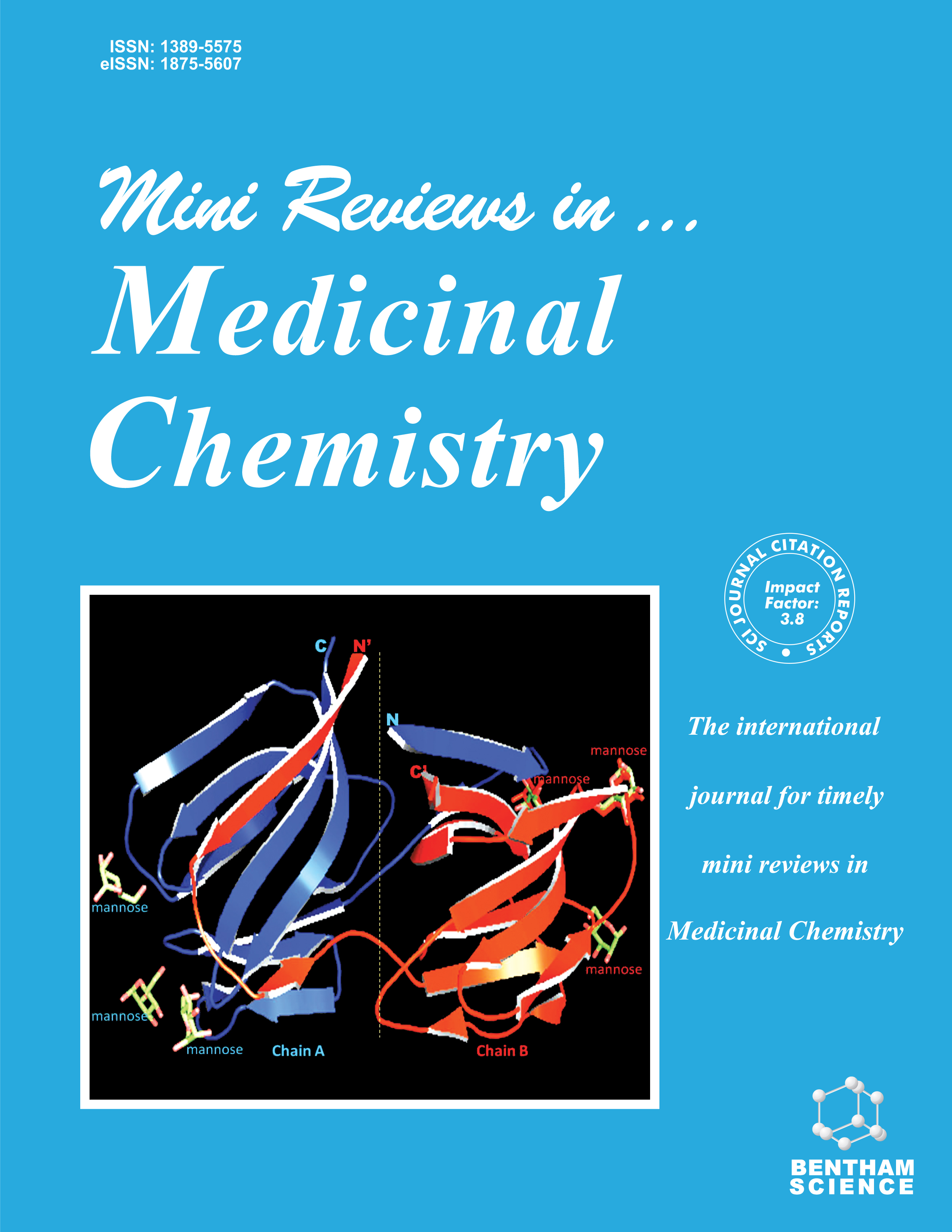- Home
- A-Z Publications
- Mini Reviews in Medicinal Chemistry
- Previous Issues
- Volume 17, Issue 12, 2017
Mini Reviews in Medicinal Chemistry - Volume 17, Issue 12, 2017
Volume 17, Issue 12, 2017
-
-
Overview of Medicinally Important Diterpenoids Derived from Plastids
More LessAuthors: Linsu Zhang and Shanfa LuBackground: Terpenoids are hydrocarbon compounds derived from common five-carbon isoprene (C5H8) building blocks. They are formed through the condensation and subsequent modification of isoprene units in various ways including 128;“ among others 128;“ cyclization and/or oxygenation. Their synthesis is localized either to the chloroplast and/or to the cytoplasm/peroxisome/endoplasmic reticulum and mitochondrion. Terp Read More
-
-
-
Lysine-derived Alkaloids: Overview and Update on Biosynthesis and Medicinal Applications with Emphasis on Quinolizidine Alkaloids
More LessAuthors: Somnuk Bunsupa, Mami Yamazaki and Kazuki SaitoBackground: Plants produce a vast variety of specialized metabolites which can be a rich source for lead compounds for the development of new drugs. Alkaloids are one the largest groups of plant specialized metabolites important for natural product based pharmaceuticals. Of these, lysine (Lys)-derived alkaloids exhibit a wide range of pharmacological properties which are beneficial for humans. For instance they have antic Read More
-
-
-
An Overview of Compounds Derived from the Shikimate and Phenylpropanoid Pathways and Their Medicinal Importance
More LessAuthors: Takayuki Tohge and Alisdair R. FernieObjective: There has been a massive increase in the number of reports about the medicinal benefits of the consumption of phenylpropanoids derived from the plastidic shikimate pathway. These benefits include anti-retroviral, anti-hypertensive, anti-inflammatory, anti-aging and insulin-sensitizing activities, the reduction of the risk of a range of chronic diseases including cardiovascular disease, cancer and osteoporosis a Read More
-
-
-
Phylloquinone (Vitamin K1): Occurrence, Biosynthesis and Functions
More LessAuthors: Gilles J. Basset, Scott Latimer, Abdelhak Fatihi, Eric Soubeyrand and Anna BlockBackground: Phylloquinone is a prenylated naphthoquinone that is synthesized exclusively by plants, green algae, and some species of cyanobacteria, where it serves as a vital electron carrier in photosystem I and as an electron acceptor for the formation of protein disulfide bonds. In humans and other vertebrates, phylloquinone plays the role of a vitamin (vitamin K1) that is required for blood coagulation and bone Read More
-
-
-
Vitamin E - Occurrence, Biosynthesis by Plants and Functions in Human Nutrition
More LessAuthors: Renata SzymaŦ#132;ska, Beatrycze Nowicka and Jerzy KrukObjective: This review examines various aspects of vitamin E, both in plant metabolism and with regard to its importance for human health. Vitamin E is the collective name of a group of lipidsoluble compounds, chromanols, which are widely distributed in the plant kingdom. Their biosynthetic pathway, intracellular distribution and antioxidant function in plants are well recognized, although their other functions are also consider Read More
-
-
-
Dibenzylbutyrolactone Lignans – A Review of Their Structural Diversity, Biosynthesis, Occurrence, Identification and Importance
More LessAuthors: Anna Solyomváry, Szabolcs Beni and Imre BoldizsarObjective: Dibenzylbutyrolactone lignans represent a unique group of plant secondary metabolites with increasing significance in medicine. This review summarizes their structural characteristics and classification, as well as the biosynthesis starting in the chloroplast, and their supposed biological activity associated with plant defense mechanisms are also discussed. Over 85 natural dibenzylbutyrolactone lignans known to Read More
-
-
-
Vitamins B1, B2, B3 and B9 – Occurrence, Biosynthesis Pathways and Functions in Human Nutrition
More LessAuthors: Natalia Wolak, Marcin Zawrotniak, Mariusz Gogol, Andrzej Kozik and Maria Rapala-KozikBackground: Vitamins are chemical compounds whose derivatives are involved in vital metabolic pathways of all living organisms. The complete endogenous biosynthesis of vitamins can be performed by many bacteria, yeast and plants, but humans need to acquire most of these essential nutrients with food. In recent years, new types of action of the well-recognized vitamins or their more sophisticated relationships have b Read More
-
-
-
Microalgal Fatty Acids and Their Implication in Health and Disease
More LessBackground: The fatty acids of seed plants and microalgae stored in triglyceride are all produced in the plastid and incorporated into triglycerides by a complex biochemical exchange between the plastid envelope and the endoplasmic reticulum. The oils of seed plants provide the basis for vegetal fat production and the microalgal fats represent an important part of the basal food web of the marine environment. The health Read More
-
Volumes & issues
-
Volume 25 (2025)
-
Volume 24 (2024)
-
Volume 23 (2023)
-
Volume 22 (2022)
-
Volume 21 (2021)
-
Volume 20 (2020)
-
Volume 19 (2019)
-
Volume 18 (2018)
-
Volume 17 (2017)
-
Volume 16 (2016)
-
Volume 15 (2015)
-
Volume 14 (2014)
-
Volume 13 (2013)
-
Volume 12 (2012)
-
Volume 11 (2011)
-
Volume 10 (2010)
-
Volume 9 (2009)
-
Volume 8 (2008)
-
Volume 7 (2007)
-
Volume 6 (2006)
-
Volume 5 (2005)
-
Volume 4 (2004)
-
Volume 3 (2003)
-
Volume 2 (2002)
-
Volume 1 (2001)
Most Read This Month
Article
content/journals/mrmc
Journal
10
5
false
en


